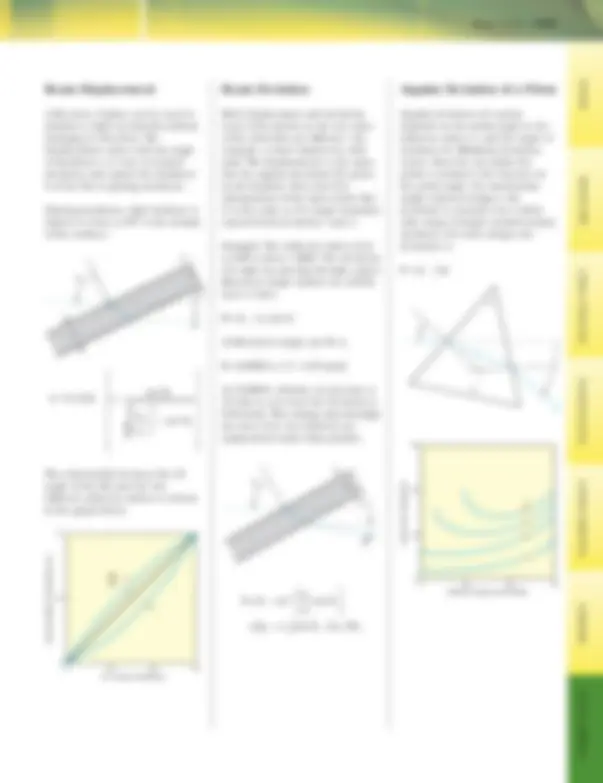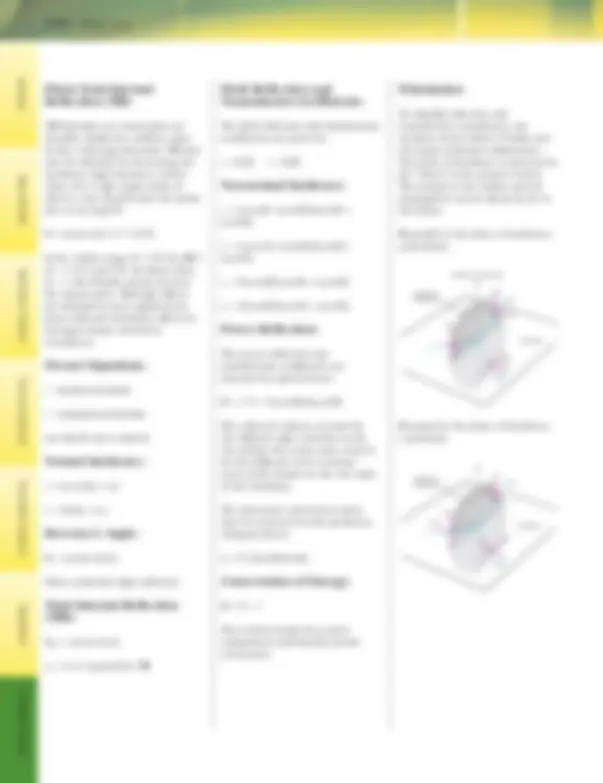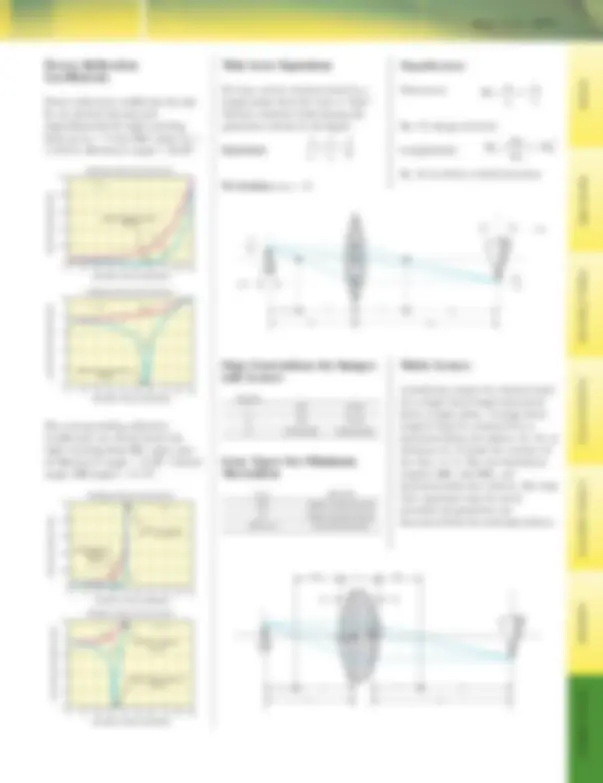





Study with the several resources on Docsity

Earn points by helping other students or get them with a premium plan


Prepare for your exams
Study with the several resources on Docsity

Earn points to download
Earn points by helping other students or get them with a premium plan
Community
Ask the community for help and clear up your study doubts
Discover the best universities in your country according to Docsity users
Free resources
Download our free guides on studying techniques, anxiety management strategies, and thesis advice from Docsity tutors
Formula sheet compiled from optics chapters in physics
Typology: Cheat Sheet
1 / 7

This page cannot be seen from the preview
Don't miss anything!





On special offer
BEAMSPLITTERS
WINDOWS
FILTERS & ATTENUATORS
ULTRAFAST LASER OPTICS
ACCESSORIES
TECHNICAL REFERENCE
POLARIZATION OPTICS
O p t i c s — 567
Light is a transverse electromagnetic wave. The electric E and magnetic M fields are perpendicular to each other and to the propagation vector k , as shown below.
Power density is given by Poynting’s vector, P , the vector product of E and H. You can easily remember the directions if you “curl” E into H with the fingers of the right hand: your thumb points in the direction of propagation.
E
k
P P = E x H
H
The nomogram below relates E , H , and the light intensity I in vacuum. You may also use it for other area units, for example, [V/mm], [A/mm] and [W/mm^2 ]. If you change the electrical units, remember to change the units of I by the product of the units of E and H: for example [V/m], [mA/m], [mW/m^2 ] or [kV/m], [kA/m], [MW/m^2 ].
1000
500
200
100
50
20
100
50
1000
20 10
2
500
200
5
1
1
2
I [W/m 2 ]
E [V/m]
H [A/m]
The light intensity, I is measured in Watts/m^2 , E in Volts/m, and H in Amperes/m. The equations relating I to E and H are quite analogous to OHMS LAW. For peak values these equations are:
ohms
n
η η
η
η
η
η η η
η η
2 2
0 0
The quantity η 0 is the wave impedance of vacuum, and η is the wave impedance of a medium with refractive index n.
0
0
0
k: wave vector [radians/m]
ν: frequency [Hertz]
ω: angular frequency [radians/sec]
λ: wavelength [m]
λ 0 : wavelength in vacuum [m]
n: refractive index
Wave Number cm 10 μm
Electron volts eV per photon
=
1
4
0
0
ν
λ
λ
[ ]
−
[ μm]
BEAMSPLITTERS
WINDOWS
FILTERS & ATTENUATORS
ULTRAFAST LASER OPTICS
ACCESSORIES
TECHNICAL REFERENCE
POLARIZATION OPTICS
568 — O p t i c s
1 nm = 10 Angstroms(Å) = 10–^9 m = 10–^7 cm = 10–^3 μm
For plane polarized light the E and H fields remain in perpendicular planes parallel to the propagation vector k as shown below.
k
E
H
x λ
Both E and H oscillate in time and space as:
sin (ωt-kx)
The nomogram relates wavenumber, photon energy and wavelength.
SOFT X—RAY
VACCUM UV 103
NEAR UV VIOLET RED 104
NEAR IR
105
FAR IR
102 102 106
103 10 104
10 4 103
(^10 5) 0.1 102
1 1
10
0.01 100 10 100
1/λ [cm—^1 ] [μm] [nm]
hv [eV]
106
105
Snell’s Law describes how a light ray behaves when it passes from a medium with index of refraction n 1 , to a medium with a different index of refraction, n 2. In general the light will enter the interface between the two medii at an angle. This angle is called the angle of incidence. It is the angle measured between the normal to the surface (interface) and the incoming light beam (see figure). In the case that n 1 is smaller than n 2 , the light is bent towards the normal. If n 1 is greater than n 2 , the light is bent away from the normal (see figure below). Snell’s Law is expressed as n 1 sinθ 1 = n 2 sinθ 2.
n 1
n (^2)
θ 1
θ 2
n 2 > n (^1)
θ 2
n 1 n 2
θ 1
n 1 > n 2
BEAMSPLITTERS
WINDOWS
FILTERS & ATTENUATORS
ULTRAFAST LASER OPTICS
ACCESSORIES
TECHNICAL REFERENCE
POLARIZATION OPTICS
570 — O p t i c s
TIR depends on a clean glass-air interface. Reflective surfaces must be free of foreign materials. TIR may also be defeated by decreasing the incidence angle beyond a critical value. For a right angle prism of index n, rays should enter the prism face at an angle θ:
θ < arcsin (((n 2 -1)1/2^ -1)/√2)
In the visible range, θ = 5.8° for BK 7 (n = 1.517) and 2.6° for fused silica (n = 1.46). Finally, prisms increase the optical path. Although effects are minimal in laser applications, focus shift and chromatic effects in divergent beams should be considered.
i - incident medium
t - transmitted medium
use Snell’s law to find θt
r = (ni-nt)/(n (^) i + nt)
t = 2n (^) i/(ni + nt)
θβ = arctan (n (^) t/ni)
Only s-polarized light reflected.
θTIR > arcsin (n (^) t/ni)
nt < ni is required for TIR
The field reflection and transmission coefficients are given by:
r = E (^) r/Ei t = E (^) t/Ei
rs = (n (^) icosθi -ntcosθt)/(n (^) icosθi + ntcosθt)
r (^) p = (n (^) tcos θi -nicosθt)/ntcosθi + n (^) icosθt )
ts = 2n (^) icosθi/(nicosθi + ntcosθt)
tp = 2n (^) icosθi/(ntcosθi + nicosθt)
The power reflection and transmission coefficients are denoted by capital letters:
R = r 2 T = t 2 (ntcosθt)/(n (^) icosθi)
The refractive indices account for the different light velocities in the two media; the cosine ratio corrects for the different cross sectional areas of the beams on the two sides of the boundary.
The intensities (watts/area) must also be corrected by this geometric obliquity factor:
It = T x I (^) i(cosθi/cosθt)
This relation holds for p and s components individually and for total power.
To simplify reflection and transmission calculations, the incident electric field is broken into two plane polarized components. The plane of incidence is denoted by the “wheel” in the pictures below. The normal to the surface and all propagation vectors ( k i, k r, k t) lie in this plane.
E parallel to the plane of incidence; p-polarized.
PLANE OFINCIDENCE
SURFACE
NORMAL TO SURFACE E (^) r k (^) r H (^) r
θr θi E (^) i k i
θt K (^) t
E (^) t H (^) t
H (^) i
E normal to the plane of incidence; s-polarized.
PLANE OF INCIDENCE
SURFACE
E (^) r k^ r
H (^) r θr θi
E (^) i k (^) i
θt K t
E t H^ t
H (^) i
BEAMSPLITTERS
WINDOWS
FILTERS & ATTENUATORS
ULTRAFAST LASER OPTICS
ACCESSORIES
TECHNICAL REFERENCE
POLARIZATION OPTICS
O p t i c s — 571
Power reflection coefficients R (^) s and R (^) p are plotted linearly and logarithmically for light traveling from air (n (^) i = 1) into BK 7 glass (n (^) t = 1.51673). Brewster’s angle = 56.60°.
FRESNEL REFLECTION FOR BK 7
0 0 10 20 30 40 50 60 70 80 90 INCIDENT ANGLE (DEGREES)
FRACTION REFLECTED
BREWSTER56.60’S ANGLE
R (^) s
1 →N
R (^) p
0
1 →N R (^) s
Rp
FRESNEL REFLECTION FOR BK 7
0 10 20 30 40 50 60 70 80 90 INCIDENT ANGLE (DEGREES)
BREWSTER56.60’S ANGLE LOG FRACTION REFLECTED
The corresponding reflection coefficients are shown below for light traveling from BK 7 glass into air Brewster’s angle = 33.40°. Critical angle (TIR angle) = 41.25°.
Rs Rp
FRESNEL REFLECTION FOR BK 7
0 0 10 20 30 40 50 60 70 80 90 INCIDENT ANGLE (DEGREES)
BREWSTERANGLE’S
CRITICAL ANGLE41.
N→ 1
FRACTION REFLECTED
Rs R (^) p
0
LOG FRACTION REFLECTED
FRESNEL REFLECTION FOR BK 7
0 10 20 30 40 50 60 70 80 90 INCIDENT ANGLE (DEGREES)
CRITICAL ANGLE
BREWSTER33.40’S ANGLE
N→ 1
If a lens can be characterized by a single plane then the lens is “thin”. Various relations hold among the quantities shown in the figure.
Gaussian:
s 1 s 2 F
Newtonian: x 1 x 2 = -F (^2)
Magnification:
Transverse: (^) M y y
s s
2 1
2 1
MT < 0, image inverted
Longitudinal: M^
x x
2 1
2
ML <0, no front to back inversion
Y (^2)
∆X 2
F F X (^2) S (^1)
X (^1)
∆X 1
Y 1
S 2
Quantity + - s 1 real virtual s 2 real virtual F convex lens concave lens
| s 2 /s 1 | Best lens <0.2 plano-convex/concave
5 plano-convex/concave 0.2 or <5 bi-convex/concave
A thick lens cannot be characterized by a single focal length measured from a single plane. A single focal length F may be retained if it is measured from two planes, H 1 , H 2 , at distances P 1 , P 2 from the vertices of the lens, V 1 , V 2. The two back focal lengths, BFL 1 and BFL 2 , are measured from the vertices. The thin lens equations may be used, provided all quantities are measured from the principal planes.
BFL 1
F
P (^1)
V 1
TC BFL (^2)
P (^2)
H (^2) V (^2) H (^1)
X 1 X 2 S 1 S 2
F
BEAMSPLITTERS
WINDOWS
FILTERS & ATTENUATORS
ULTRAFAST LASER OPTICS
ACCESSORIES
TECHNICAL REFERENCE
POLARIZATION OPTICS
O p t i c s — 573
Source (nm) ArF 193 KrF 248 Nd:YAG(4) 266 XeCl 308 HeCd 325, 441. N 2 337.1, 427 XeF 351 Nd:YAG(3) 354. Ar 488, 514.5, 351.1, 363. Cu 510.6, 578. Nd:YAG(2) 532 HeNe 632.8, 543.5, 594.1, 611.9, 1153, 1523 Kr 647.1, 676. Ruby 694. Nd:Glass 1060 Nd:YAG 1064, 1319 Ho:YAG 2100 Er:YAG 2940
The Gaussian intensity distribution:
I(r) = I(0) exp(-2r^2 /ω 02 )
is shown below.
0
(^0) 0.23 0.59 1. 0
e- e-
NORMALIZED RADIUS (r/ω 0 )
RELATIVE INTENSITY 1 2
The right hand ordinate gives the fraction of the total power encircled at radius r:
P r( ) = P ( ∞) (^) [ 1 − exp (^) (− 2 r 2 / ω 02 )]
The total beam power, P(∞) [watts], and the on-axis intensity I(0) [watts/area] are related by:
P I I P
( ) / ( ) ( ) / ( )
∞ = ( ) = ( ) ∞
πω πω
0 2
0 2
2 0 0 2
The figure below compares the far- field intensity distributions of a uniformly illuminated slit, a circular hole, and Gaussian distributions with 1/e 2 diameters of D and 0.66D (99% of a 0.66D Gaussian will pass through an aperture of diameter D). The point of observation is Y off axis at a distance X>Y from the source.
-4.0 0 0.5 1.0 1.5 2.
-3.
-2.
-1.
0 0.66 DD
D
LOG INTENSITY D
DY/ λX
In the figure below the 1/e 2 radius, ω(x), and the wavefront curvature, R(x), change with x through a beam waist at x = 0. The governing equations are:
ω ω λ ω
πω λ
2 0 2 0 2 2
0 2 2
1
1
( ) /
( ) /
x x
R x x x
= + ( ) ^
= + ( ) ^
2 ω 0 is the waist diameter at the 1/e 2 intensity points. The wavefronts are planar at the waist [R(0) = ∞].
At the waist, the distance from the lens will be approximately the focal length: s 2 ≈F.
D = collimated beam diameter or diameter illuminated on lens.
F D
f-number ≡ f/# =
S (^2)
D ω 0
R(X)
ω(X) X X = 0
θ
DOF = (8λ/π)(f/#)^2
Only if DOF <F, then:
ω 0 f
λ π
λ π
θ = ( /#)f −^1